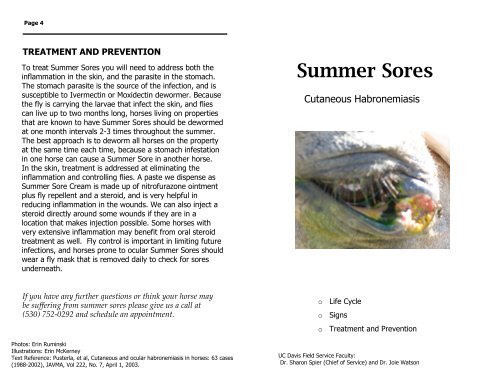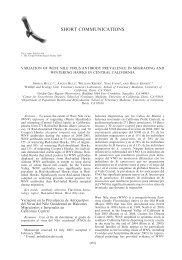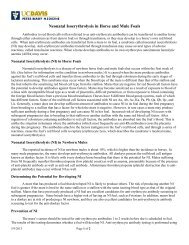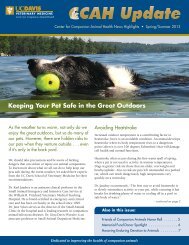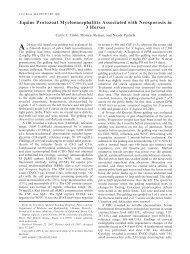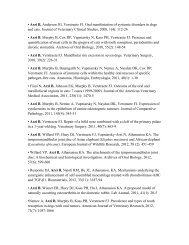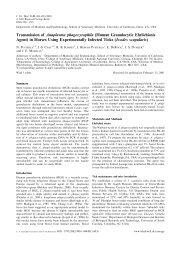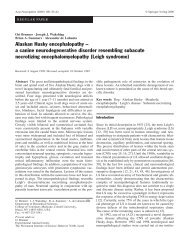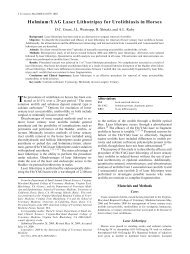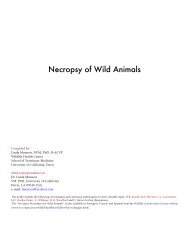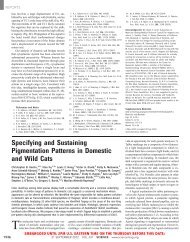"Summer Sores?" (pdf)
"Summer Sores?" (pdf)
"Summer Sores?" (pdf)
You also want an ePaper? Increase the reach of your titles
YUMPU automatically turns print PDFs into web optimized ePapers that Google loves.
Page 4<br />
TREATMENT AND PREVENTION<br />
To treat <strong>Summer</strong> <strong>Sores</strong> you will need to address both the<br />
inflammation in the skin, and the parasite in the stomach.<br />
The stomach parasite is the source of the infection, and is<br />
susceptible to Ivermectin or Moxidectin dewormer. Because<br />
the fly is carrying the larvae that infect the skin, and flies<br />
can live up to two months long, horses living on properties<br />
that are known to have <strong>Summer</strong> <strong>Sores</strong> should be dewormed<br />
at one month intervals 2-3 times throughout the summer.<br />
The best approach is to deworm all horses on the property<br />
at the same time each time, because a stomach infestation<br />
in one horse can cause a <strong>Summer</strong> Sore in another horse.<br />
In the skin, treatment is addressed at eliminating the<br />
inflammation and controlling flies. A paste we dispense as<br />
<strong>Summer</strong> Sore Cream is made up of nitrofurazone ointment<br />
plus fly repellent and a steroid, and is very helpful in<br />
reducing inflammation in the wounds. We can also inject a<br />
steroid directly around some wounds if they are in a<br />
location that makes injection possible. Some horses with<br />
very extensive inflammation may benefit from oral steroid<br />
treatment as well. Fly control is important in limiting future<br />
infections, and horses prone to ocular <strong>Summer</strong> <strong>Sores</strong> should<br />
wear a fly mask that is removed daily to check for sores<br />
underneath.<br />
If you have any further questions or think your horse may<br />
be suffering from summer sores please give us a call at<br />
(530) 752-0292 and schedule an appointment.<br />
Photos: Erin Ruminski<br />
Illustrations: Erin McKerney<br />
Text Reference: Pusterla, et al, Cutaneous and ocular habronemiasis in horses: 63 cases<br />
(1988-2002), JAVMA, Vol 222, No. 7, April 1, 2003.<br />
<strong>Summer</strong> <strong>Sores</strong><br />
Cutaneous Habronemiasis<br />
o Life Cycle<br />
o Signs<br />
o Treatment and Prevention<br />
UC Davis Field Service Faculty:<br />
Dr. Sharon Spier (Chief of Service) and Dr. Joie Watson
Page 2 Page 3<br />
WHAT ARE “SUMMER SORES”?<br />
<strong>Summer</strong> <strong>Sores</strong> can occur in any breed or age of<br />
horse, mule, or donkey. Lesions typically appear<br />
on the skin or near the eyes, but are actually<br />
caused by a worm that lives in the stomach. The<br />
worms Habronema muscae, Habronema<br />
microstoma, and Draschia megastoma can each<br />
be the inciting cause of Cutaneous or Ocular<br />
Habronemiasis, the condition known as <strong>Summer</strong><br />
<strong>Sores</strong>. When these worms are in the stomach<br />
they generally do not cause the horse significant<br />
internal disease, but they produce larvae that are<br />
passed through the digestive tract and end up in<br />
the horse’s manure. These larvae are then picked<br />
up by flies. When a fly lands on an open sore or a<br />
mucous membrane such as at the corners of the<br />
eyes or the edges of the lips, they can deposit<br />
the larvae into the horse’s skin. The larvae<br />
themselves will not develop into worms in the<br />
skin, but in some horses can create a very<br />
intense allergic reaction that causes a large<br />
amount of inflammation. This inflammatory<br />
reaction creates the summer sore. The sores will<br />
often be itchy and horses may try to rub or<br />
scratch the area, making it even more irritated<br />
and inflamed.<br />
Sulfur granules from a summer sore<br />
wound<br />
The adult fly may<br />
deposit larvae on<br />
the skin, inside<br />
wounds, near the<br />
eyes or around the<br />
lips etc. which can<br />
cause <strong>Summer</strong><br />
<strong>Sores</strong>.<br />
The fly larvae form<br />
pupae in the<br />
soil/manure and the<br />
nematode molt to L3<br />
larvae inside the pupae.<br />
If the fly is ingested or larvae<br />
are swallowed the nematode<br />
larvae are released in the<br />
stomach.<br />
Fly larvae eat L1 larvae of<br />
the nematode. The<br />
nematode larvae molt to<br />
L2 inside the fly larvae.<br />
HOW TO RECOGNIZE SUMMER SORES<br />
Adult worms live in<br />
the stomach, eggs<br />
are shed in manure.<br />
Dung Pile- eggs hatch<br />
to first stage<br />
nematode (L1)<br />
larvae.<br />
The most common sites for <strong>Summer</strong> <strong>Sores</strong> are around the eyes, the edges of the mouth, around<br />
the lips, external genitalia, and on the distal limbs, especially around the fetlocks and coronary<br />
band. The sores can happen anywhere on the horse but do commonly occur in areas where a<br />
wound or laceration has occurred. When caring for a wound in the summer months watch for<br />
development of granulation tissue, and swelling under the skin associated with a wound that is<br />
often itchy. Granulation tissue is moist, pink, irregular scar-like tissue that can develop and grow<br />
rapidly. Within the sore you may see some small, hard, yellow grains known as “sulfur<br />
granules”—these are not actually sulfur, but are a tissue reaction to the inflammation and are<br />
not always visible in the wound.


